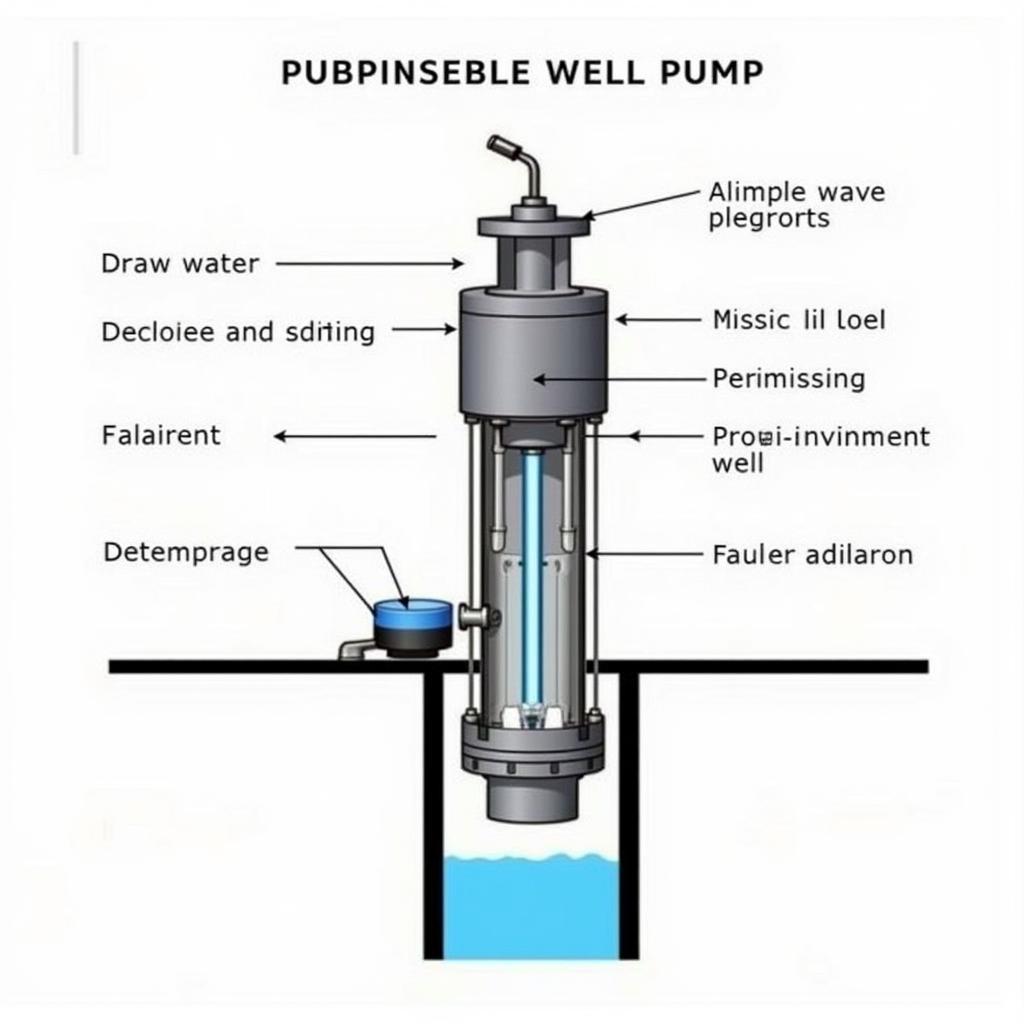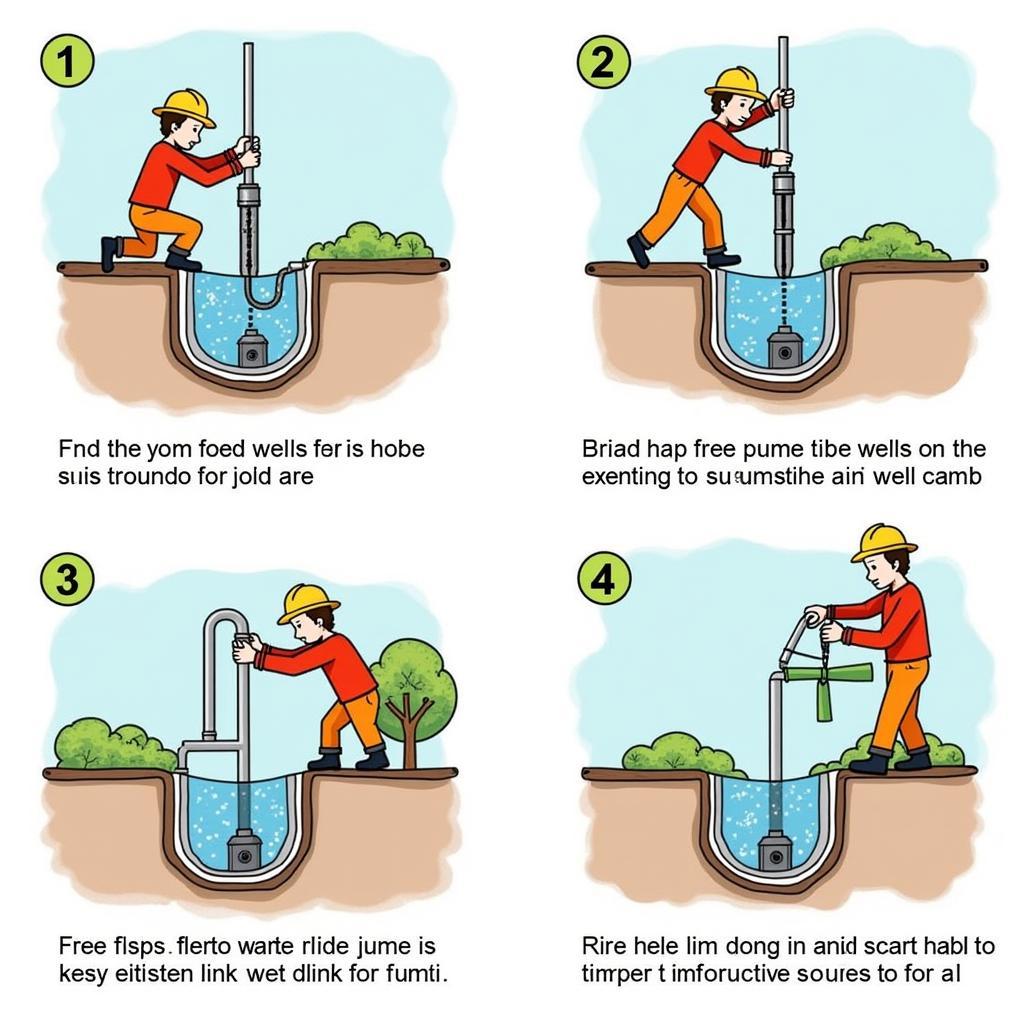Choosing the right submersible well pump for your horses and livestock is crucial for ensuring a constant supply of clean, fresh water. A “1 2 Horse Submersible Well Pump” typically refers to a pump suitable for providing water for one or two horses, but this can vary depending on factors like your well depth, water table, and your animals’ water needs. This comprehensive guide will equip you with all the information you need to make an informed decision and keep your equine companions hydrated and healthy.
Understanding Submersible Well Pumps
 Submersible Well Pump Diagram
Submersible Well Pump Diagram
Unlike jet pumps situated above ground, submersible well pumps are submerged within the well water itself. This placement offers several advantages, including:
- Quieter operation: The submersion muffles operational noise, making them ideal for noise-sensitive horses.
- Increased efficiency: Being closer to the water source reduces pumping effort, leading to lower energy consumption.
- Reduced risk of freezing: Submerged pumps are less susceptible to freezing in cold climates.
Factors to Consider When Choosing a Pump
Selecting the optimal 1 2 horse submersible well pump requires careful consideration of several crucial factors:
- Horse Water Consumption: Horses are large animals with significant water requirements, typically consuming 5-10 gallons per day. This amount can fluctuate depending on factors such as breed, activity level, climate, and lactation stage.
- Well Depth and Water Table: These factors dictate the pump’s power requirements to lift water effectively. Consult a well professional for accurate measurements.
- Flow Rate and Pressure: The pump must deliver sufficient water flow (gallons per minute – GPM) and pressure (pounds per square inch – PSI) to meet your horses’ needs and any additional water usage on your property.
- Horse Trough Capacity and Location: Consider the size and placement of your water troughs in relation to the well to determine the appropriate pump and piping size.
- Power Source: Submersible well pumps are available in both AC (alternating current) and DC (direct current) options, with AC being more common for residential wells.
- Budget and Long-Term Costs: While initial cost is a factor, prioritize quality and durability for long-term cost savings and fewer maintenance issues.
Benefits of a Dedicated Well Pump for Horses
Investing in a dedicated 1 2 horse submersible well pump offers numerous benefits:
- Consistent Water Supply: Ensures your horses have access to a reliable source of fresh water, crucial for their health and well-being.
- Reduced Risk of Water Contamination: Separate pumps for livestock and household use prevent cross-contamination from potential contaminants in the well water.
- Increased Water Pressure: Dedicated pumps provide optimal water pressure for filling troughs quickly and efficiently.
Installation and Maintenance Tips
 Installing a Submersible Well Pump
Installing a Submersible Well Pump
Proper installation and regular maintenance are essential for the longevity and efficiency of your submersible well pump:
- Professional Installation: Enlist the expertise of a qualified well contractor for proper installation to avoid costly mistakes.
- Regular Inspections: Inspect the well and pump system annually for signs of wear and tear, leaks, or damage.
- Water Testing: Schedule regular water quality testing to ensure your horses’ water is free from harmful contaminants.
- Preventative Maintenance: Implement a preventive maintenance schedule that includes cleaning the pump and checking electrical components.
FAQs
Q: Can I use my existing well pump for my horses?
A: While it’s possible, a dedicated well pump for your horses offers several advantages, including a consistent water supply, reduced contamination risks, and optimal water pressure.
Q: How often should I clean my horse’s water trough?
A: Clean and refill your horse’s water trough at least once a day, more frequently in hot weather or if the water becomes soiled.
Q: What are signs of a failing well pump?
A: Common signs include low water pressure, sputtering faucets, air in the water lines, and unusual noises from the pump.
Other Considerations
Beyond choosing the right pump, consider these additional factors:
- Water Trough Placement: Strategically locate troughs to minimize mud and contamination from manure.
- Heated Water Troughs: In colder climates, heated troughs ensure your horses have access to unfrozen water.
- Water Testing Kits: Regularly test your well water for contaminants and adjust filtration systems accordingly.
For further information on well pumps and water management for your horses, explore these resources:
Conclusion
Selecting the right 1 2 horse submersible well pump is an investment in your horses’ health and well-being. By carefully considering your needs and following the guidance in this guide, you can ensure your equine companions have access to the fresh, clean water they need to thrive.
Need expert advice on choosing the perfect well pump? Contact us at Phone Number: 0772127271, Email: [email protected] or visit us at QGM2+WX2, Vị Trung, Vị Thuỷ, Hậu Giang, Vietnam. Our dedicated team is available 24/7 to assist you.